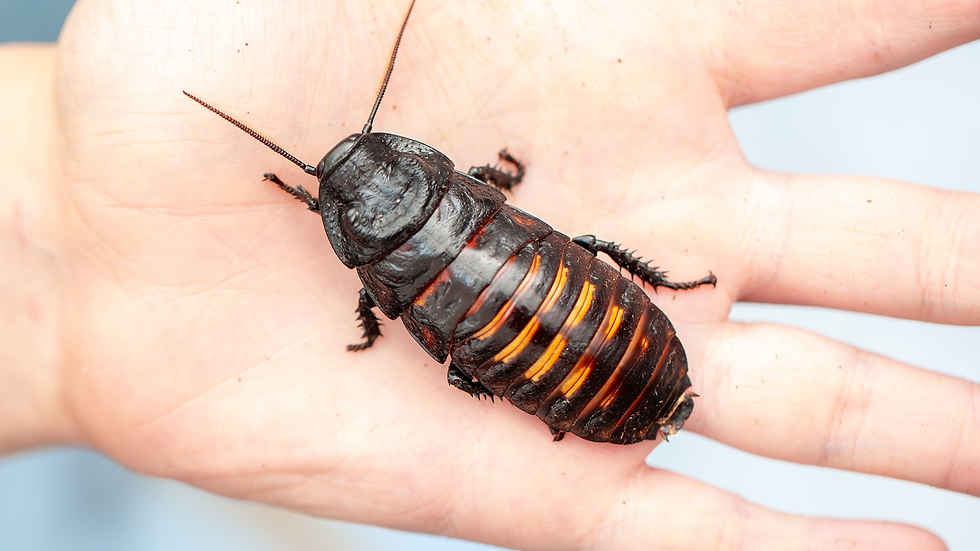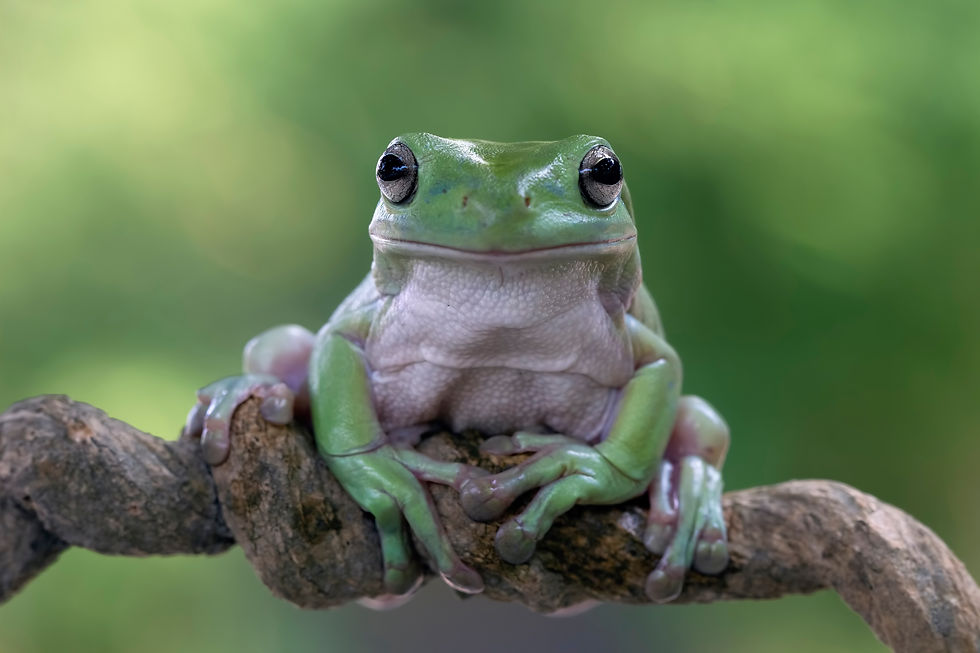Animal Phobias: Top Tips You Need To Know
- Dane
- Jul 23
- 5 min read
Updated: Jul 30

At ZooLab, our Rangers meet people of all ages with phobias of some of our creatures.
In this blog, we’ll discuss what phobias are, the most common animal fears that we encounter, why they happen, and some top tips to help you see our extraordinary creatures in a whole new light.
What are phobias?
Have you heard of the brain’s ‘fight or flight’ response? In order to deal with perceived threats, the brain encourages us to run or fight environmental threats - it is a primal trait passed on by our ancient ancestors. Fear keeps us safe - for the most part. However, our fear receptors can trigger when a threat is non-existent or greatly exaggerated, and from here, an irrational phobia is born.
Let’s run through some animal phobias that we encounter at our sessions…

Katsaridaphobia – Fear of cockroaches
Cockroaches have a bit of a bad rep, which is not made easier by their portrayal in media. Cockroaches have been portrayed as evil in films and TV shows, like ‘The X-Files’, which showed cockroaches grouped to murder people. The evil connotations portrayed in the media can contribute towards cockroach phobia.
Cockroaches also have a reputation for being dirty and pests, but only 30 out of 4,500 species of cockroaches are considered pests - that is less than 1%! ZooLab’s cockroaches are different - Madagascan hissing cockroaches are native to the Rainforests, and unlike their cousins, they avoid human dwellings.
Lack of education about these creatures can result in an irrational fear of cockroaches. Our rangers strive to educate and inspire audiences to have a better understanding and awareness of these creatures. We can learn a lot from these six-legged critters. Engineers are studying how cockroaches manoeuvre their environment to make robots more robust (find out more here).

Ranidaphobia – Fear of frogs
Children’s fairy tales and folklore may place frogs in a negative light. These ideas are compounded by cultural norms and people’s attitudes towards frogs. Frogs have a slimy appearance, which some people find disgusting and repulsive. In Shakespeare’s Macbeth, as the three witches stir their boiling cauldron, the toe of frog was one of the many ingredients included. However, further research reveals that the "toe of frog" was actually buttercups!
On the other hand, many cultures believe that the frog is a symbol of fertility, transformation, change, and good luck. During our sessions, ZooLab rangers will introduce you to White’s Tree frogs (Litoria caerulea). These amphibians are docile and very people-friendly, making them ideal candidates to help people overcome their phobias.

Arachnophobia: Fear of spiders
If you suffer from this, you are not alone - arachnophobia is thought to be the most common animal phobia in the UK! An interesting study from the Institute for Human Cognitive and Brain Sciences in Germany suggests that this phobia may have an evolutionary origin. They believe that over time, our ancestors adapted to have an inbuilt survival instinct against our eight-legged friends and that this still exists in us today.
Adults who have a fear of spiders most often develop arachnophobia as young children - their parents or friends feared them, and this reaction became a conditioned response. Often when we are on visits, we find that younger participants are the keenest to meet our tarantulas - they don’t yet know that this is something to be ‘feared’!
Spiders are essential for a healthy ecosystem; without them, the world would be full of pests and disease. We have learned a lot from them - spider venom is used in medicine, and engineers have been inspired by spider silk in the creation of military grade armour.

Muriphobia: Fear of mice and rats
Rats tend to divide a ZooLab audience - while a lot of people see their cute faces and playful nature, others fear or dislike them for a few reasons that we will discuss below. Some consider rats to be unclean; however, they actually clean themselves around 20 times a day. Cats and dogs are MORE likely to catch and transmit parasites and viruses than a pet rat.
Throughout history, rats have been associated with the spread of disease. The infamous Black Death, which killed tens of millions of people in the mid-1300s, was blamed on rats. However, it was not rats that carried the disease, but fleas that were carried on people.
In recent years, due to their intelligence, rats have gained a spot working alongside charities and medical staff - their extremely well-developed sense of smell has been used to detect TNT in landmines and TB in patients’ saliva.

Ophidiophobia: Fear of snakes
Ophidiophobia is the irrational fear of snakes and is more common than you may think. Experts believe that as many as 1/3 of adults could be ophidiophobic. Our Rangers often find that the most common reason for acute snake phobias is the lack of knowledge about our scaly friends.
A study from anthropologists at the University of California suggests that to survive, our ancestors adapted to recognise and respond quickly to snakes. While studies agree that humans have a predisposition to detect snakes, many argue that children are not born with fear. Rutgers University, New Jersey, showed babies videos of snakes monitoring startle response and heart rate - both of which were lower when our slithery friends were present, indicating that the babies were not scared. None of the three species of snake native to the UK - adder, barred grass snake and smooth snake - are deadly to humans and will shy away from human interaction.
Snakes are vital to the ecosystem, helping to keep rodent populations in balance. In doing so, they reduce the spread of Lyme's disease and other tick-borne diseases and aid farmers by preying upon pests that damage crops. Venom can be used in treatments for a range of different illnesses, including cancer, high blood pressure, and Alzheimer’s.

ZooLab’s phobia top tips
If you don’t share a phobia with someone, it can be difficult and sometimes challenging to understand their fear. It can also be difficult to get through a phobia by yourself. Our top tips to help overcome your or someone else’s phobia are…
Be open-minded. Phobias may seem irrational, but the fear feels all too real. Try not to judge another person for their reaction to their fear animal and take it seriously.
Be an ear to talk to. Sometimes the best way to get over something is to talk it through with others and gain an insight into other ways of thinking.
Do some research. Find out why this fear may exist and understand more about what can be done to overcome it.
Go slowly! Don’t push yourself or anyone else to suddenly be fine around their fear animal. Change takes time, and pushing someone into a situation which triggers the fear will negatively affect their mental health.
Be brave! Although it’s not the best course of action to jump headfirst into overcoming your fears, baby steps are the best way to slowly build up resilience. A supervised animal encounter is a great place to start!




Comments